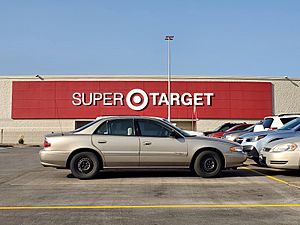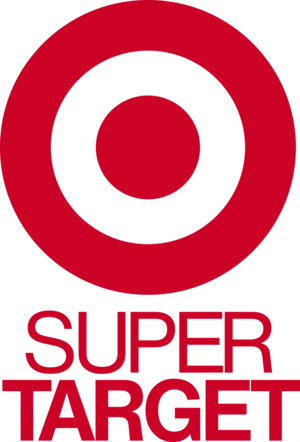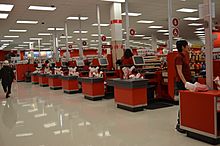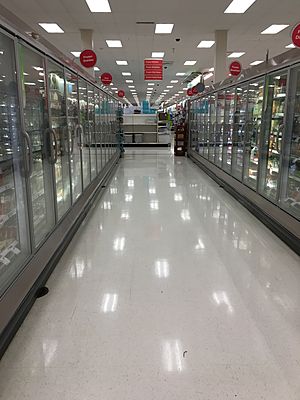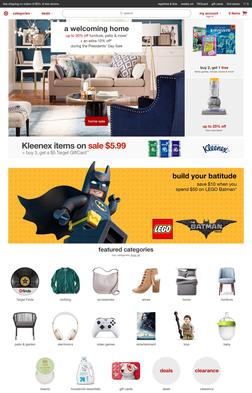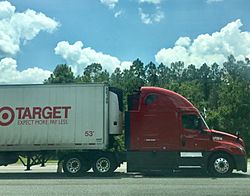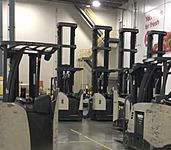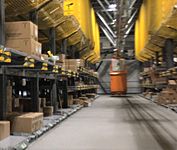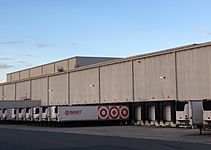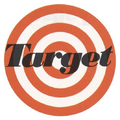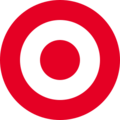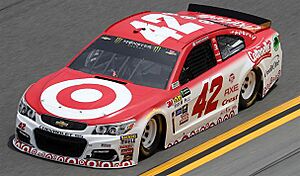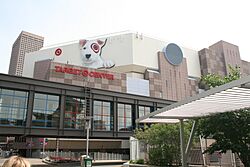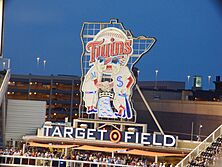Target Corporation facts for kids
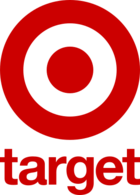 |
|
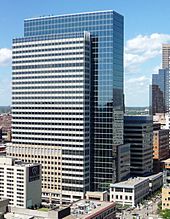
Corporate headquarters, Target Plaza, in Minneapolis
|
|
|
Formerly
|
|
|---|---|
| Public | |
| Traded as | |
| Industry | Retail |
| Founded |
|
| Founders |
|
| Headquarters |
|
|
Number of locations
|
|
|
Area served
|
United States, Canada (formerly, see Target Canada) |
|
Key people
|
Brian C. Cornell (chairman and CEO) |
| Products | Clothing, designers, footwear, accessories, jewelry, beauty products, groceries, food, drinks, electronics, housewares, appliances, bedding, bath, furniture, home decor, books, toys, games, movies, music, lawn and garden, pet supplies, health and hygiene products, gifts, optical, snack bar, and pharmacy |
| Revenue | |
|
Operating income
|
|
| Total assets | |
| Total equity | |
|
Number of employees
|
440,000 (2025) |
| Parent |
|
| Subsidiaries | Shipt |
Target Corporation, often called Target, is a big American company. It runs many discount department stores and hypermarkets. Its main office is in Minneapolis, Minnesota. Target is the seventh-largest retailer in the United States. It is also one of the biggest private employers in the country.
The first Target store was started by John Geisse and Douglas Dayton in 1962. The company that owned it, Dayton Corporation, was founded by George Dayton in 1902. Over the years, the company grew by adding more stores and buying other businesses. In 1969, it became Dayton-Hudson Corporation. Then, in 2000, it changed its name to Target Corporation. Target Corporation is not connected to Target Australia, even though they have similar names and logos.
Target is known for selling stylish items at lower prices. Its stores usually sell clothes, home goods, electronics, and toys. They also sell groceries. The company's name and logo look like the center of a shooting target. Its dog mascot is named Bullseye. Target grew across the United States in the late 1900s. Its main rivals are Walmart and Amazon. The company also has many distribution centers and other offices.
As of 2024, Target has 1,978 stores in the United States. It is ranked 32nd on the Fortune 500 list. Target is often seen as one of the most generous companies in the U.S. It gives a lot to charity. Target's attempts to open stores in other countries have not worked out well.
Contents
- Target's Journey: A Look at Its History
- Different Kinds of Target Stores
- Target's Own Brands and Other Businesses
- How Target Gets Products to Stores
- Target's Main Office and Leadership
- Target's Focus on Diversity
- Target's Giving Back to Communities
- Target's Environmental Efforts
- Customer Information Safety
- Target Around the World
- How Target Treats Its Employees
- Target's Brand and How It's Different
- Target's Forensic Services
- Target's Major Sponsorships
- Images for kids
- See also
Target's Journey: A Look at Its History
The story of Target Corporation began in June 1902. That is when George Dayton bought a company called Goodfellow Dry Goods. The company changed its name to Dayton's Dry Goods Company in 1903. It became the Dayton Company in 1910. The first Target store opened in Roseville, Minnesota, in 1962. The main company was renamed Dayton Corporation in 1967.
It became the Dayton-Hudson Corporation in 1969 after joining with the J. L. Hudson Company. This company owned several department stores like Dayton's, Hudson's, Marshall Field's, and Mervyn's. In 2000, the Dayton-Hudson Corporation changed its name to Target Corporation.
Different Kinds of Target Stores
Regular Target Stores
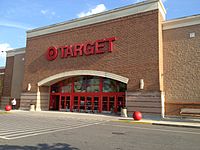
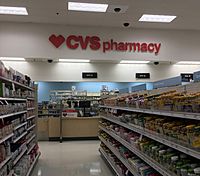
The first Target discount store opened in Roseville, Minnesota, on May 1, 1962. Today's regular Target stores are about 135,000 square feet. They sell many different items, including clothes, electronics, and home goods. Many Target stores look like large big-box buildings. However, since 2006, Target has tried to make each new store fit its local neighborhood.
Many Target stores have Starbucks coffee counters. They also often have Pizza Hut Express counters in their snack bars. In 2008, Target started a "PFresh" plan. This plan added more groceries to regular stores. These stores sell fresh and frozen foods, baked goods, meat, and dairy. Stores with PFresh are a bit larger. Target changed 109 stores in 2009 and 350 more in 2010. Target also closed its garden centers. This made more space for PFresh and seasonal items.
CVS Health Services
On June 15, 2015, CVS Health bought all of Target's pharmacies and clinics. This deal was worth about $1.9 billion. Target pharmacies became CVS Health pharmacies. Target clinics were renamed MinuteClinic. This helped CVS grow into new cities like Seattle and Denver.
SuperTarget Stores
The first Target Greatland store opened in Apple Valley, Minnesota, in September 1990. These stores were about 50% larger than regular Target stores. They had more checkout lanes, bigger aisles, and larger pharmacy areas. Target Greatland stores have since become PFresh stores.
The first SuperTarget hypermarket opened in Omaha, Nebraska, in 1995. These stores were even bigger than Target Greatland. They included a full grocery section. In the early 2000s, some SuperTarget stores had E-Trade trading stations. However, these were all closed by 2003.
SuperTarget stores are different from Walmart Supercenters. Walmart focuses more on groceries. Target sees its grocery section as a helpful extra. As of September 2015, Target had 239 SuperTarget stores. Each one is about 174,000 square feet. Since August 2015, Target has decided to call all its stores "Target," whether they are big or small.
Smaller Target Stores
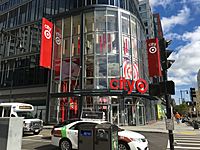
Regular Target stores are about 135,000 square feet. But "small-format" CityTarget stores are usually around 80,000 square feet. The first CityTarget stores opened in July 2012 in Chicago, Los Angeles, and Seattle. The Boston location, opened in July 2015, is the largest CityTarget at 160,000 square feet.
TargetExpress stores are even smaller, from 14,000 to 21,000 square feet. The first one opened in Dinkytown near the University of Minnesota in July 2014. These smaller stores sell products in smaller packages. This is helpful for customers who use public transportation. Stores near colleges often have more furniture for dorms. In August 2015, Target decided to rename all CityTarget and TargetExpress stores to simply "Target." This change happened in October 2015.
Newer small-format stores opened in Chicago, Rosslyn, San Diego, and San Francisco. In October 2016, a 45,000 square foot store opened in Tribeca, New York. Other similar-sized stores opened in Philadelphia, Cupertino, California, and near Pennsylvania State University. Target also opened a 22,000 square foot store in Austin, Texas, near the UT-Austin campus. Most new Target stores planned through 2019 were small-format. These smaller stores aim to attract younger customers.
Target's Own Brands and Other Businesses
As of 2018, Target has four main businesses: Target Brands, Inc., Target Capital Corporation, Target Enterprise, Inc., and Target General Merchandise, Inc. Target Australia used to be part of Target Corporation. This was from 1968 until 1985, when it was sold.
Financial Services
Target's Financial and Retail Services (FRS) handles Target's credit cards. These are called the Target REDcard. FRS also manages GiftCard balances. Target also has a debit card called the Target Debit Card. This card takes money directly from a customer's bank account. It also lets customers get up to $40 "cash back." The debit card gives guests 5% off every purchase.
Target Sourcing Services
Target Sourcing Services (TSS) finds products from all over the world for Target stores. It helps bring these products to the United States. This includes clothes, furniture, and towels. TSS has offices around the world. Its engineers check factories that work with Target. They make sure products are good quality and that workers are treated fairly. TSS was bought by Target Corporation in 1998. It was first started in 1916.
Target's Own Brands
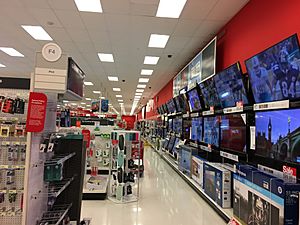
Target Brands manages the company's own product lines, called private-label brands. Bullseye, a white Bull Terrier, is Target's mascot. Here are some of Target's popular brands:
- Good & Gather: Food and drink items.
- Market Pantry: Everyday grocery products.
- Dealworthy: Low-priced essential items.
- Boots & Barkley: Pet food and supplies.
- Embark: Outdoor gear for camping and travel.
- Room Essentials: Affordable furniture, often easy to assemble.
- Brightroom: Storage solutions for your home.
- Threshold: A higher-quality furniture line.
- Wondershop: Christmas decorations.
- Hyde and Eek: Halloween decorations.
- up&up: Household, health, beauty, and baby products.
- Xhilaration: Underwear, sleepwear, and swimwear.
Other brands launched in 2016 include:
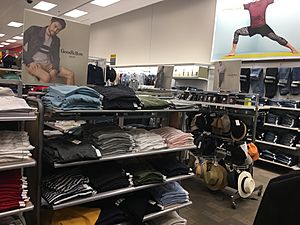
- Pillowfort: Children's bedding.
- Cat and Jack: Children's clothes and accessories.
- Cloud Island: Baby bedding and clothing.
- Project 62: Home goods.
- Goodfellow & Co.: Men's clothing and personal care. This name honors Target's start as Goodfellow Dry Goods.
- A New Day: Women's clothing.
- JoyLab: Women's fitness clothing.
- Hearth and Hand: Home and lifestyle items, with designer Joanna Gaines.
Eight new brands launched in 2018:
- Universal Thread: A denim clothing brand.
- Opalhouse: Unique home decor.
- Heyday: Electronic accessories.
- Original Use: Men's clothing for younger generations.
- Wild Fable: Women's clothing for younger generations.
- Made By Design: Home basics like towels and kitchen tools.
- Smartly: Everyday items like household and beauty products.
In 2019, Target released three new brands for women's underwear, loungewear, and sleepwear:
- Auden: Underwear and lingerie.
- Stars Above: Sleepwear.
- Colsie: Underwear and loungewear.
On January 9, 2020, Target announced All in Motion. This is a new activewear brand for men, women, boys, and girls. Its logo looks like an old Dayton's logo.
On March 9, 2021, Target announced a new food brand called Favorite Day. It sells bakery items, snacks, candy, ice cream, and drink mixers. It launched on April 5, 2021.
Some former brands include:
- Cherokee: Children's and women's clothing. Target stopped selling this brand in 2017. It was replaced by Cat & Jack.
- Circo: Toddler's and kids' clothing. This brand was also replaced by Cat & Jack.
- Merona: A clothing brand Target bought in 1991.
- Mossimo Supply Co.: A clothing line.
- Gilligan & O'Malley: Underwear and sleepwear lines. These were stopped after the new brands Auden, Stars Above, and Colsie came out.
Target's Website
|
Type of site
|
E-commerce |
|---|---|
| Commercial | Yes |
| Registration | Optional but required for some features |
| Launched | 2000 August 2011 (rebrand) |
| Current status | Online |
Target.com manages the company's online shopping. It started in early 2000 as target.direct. In 2002, Target.com worked with Amazon.com. Amazon handled orders and customer service for Target.com. This partnership ended in 2011. Target then built its own online platform. This new Target.com officially launched on August 23, 2011. Target has been working to improve how it delivers online orders.
Past Businesses
- Target Portrait Studio was a photo studio chain inside some Target stores. It closed on January 28, 2017.
- Target Garden Center was a chain of garden centers in some Target stores. All of them closed in September 2010. Target said they were not making enough money.
- Target Canada was a chain of Target stores in Canada. It started in 2013 when Target bought Zellers leases. Target Canada operated for two years. All stores closed in 2015. This was a big financial loss for Target.
How Target Gets Products to Stores
As of May 2016, Target Corporation has 41 distribution centers in the United States. These centers send items directly to Target stores. However, groceries often come from other companies that Target works with.
The first distribution center opened in Fridley, Minnesota, in 1969. It had a computer system to help with distribution. In 2004, Target tested using radio-frequency identification (RFID) tags. These tags helped track goods from suppliers to stores. In 2016, Target planned to use RFID technology in all its stores.
Target opened new distribution centers in 2006 in Rialto, California, and DeKalb, Illinois. In 2009, Target closed its distribution center in Maumelle, Arkansas. This was to help the company stay competitive. In June 2009, a new distribution center opened to supply over 60 stores.
SuperTarget and PFresh stores need fresh and frozen foods. Target has used food distribution centers owned by SuperValu for many years. Target built a new food distribution center in Lake City, Florida. It was run by SuperValu until 2011, then Target took over. Target also works with other companies for food delivery in different regions.
Target has four places to receive shipments from overseas. These are near ports in Rialto, California; Savannah, Georgia; Lacey, Washington; and Suffolk, Virginia. Items received here are sent to regional distribution centers. Online orders from Target.com are handled in Woodbury, Minnesota, with help from other locations. In 2021, during the COVID-19 pandemic, Target hired over 30,000 new supply chain workers.
Distribution Centers Across the U.S.
-
T-3892 Target food distribution center in Lake City, Florida
-
T-0556 Target regional distribution center in Tifton, Georgia
| Distribution center | Type | Location |
|---|---|---|
| T-580 | Regional | Madison, Alabama |
| T-588 | Phoenix, Arizona | |
| T-9478 | E-commerce fulfillment | Tucson, Arizona |
| T-0553 | Regional | Fontana, California |
| T-9479 | E-commerce Fulfillment | Ontario, California |
| T-3806 | Regional | Rialto, California |
| T-3807 | Import | |
| T-3899 | Food | |
| T-0593 | Regional | Shafter, California |
| T-0555 | Woodland, California | |
| T-0554 | Pueblo, Colorado | |
| T-3892 | Food | Lake City, Florida |
| T-3808 | Regional | Midway, Georgia |
| T-3862 | Lawrenceville, Georgia | |
| T-3810 | Import | Savannah, Georgia |
| T-0556 | Regional | Tifton, Georgia |
| T-3865 |
|
Chicago, Illinois |
| T-3897 | Consolidation Center | Elwood, Illinois |
| T-9275 | Speciality Distribution (SDC) | Joliet, Illinois |
| T-3809 | Regional | DeKalb, Illinois |
| – | Central returns | Indianapolis, Indiana |
| T-0559 | Regional | |
| T-0590 | Cedar Falls, Iowa | |
| T-3895 | Food | |
| T-3803 | Regional | Topeka, Kansas |
| T-0587 | Galesburg, Michigan | |
| T-0551 | Fridley, Minnesota | |
| T-9407 | E-commerce fulfillment | Woodbury, Minnesota |
| T-3844 | Perth Amboy, New Jersey | |
| T-3857 | Flow Center, UDC, RDC, E-commerce | Logan Township, New Jersey |
| T-9156 | E-commerce fulfillment | Burlington, New Jersey |
| T-3802 | Regional | Amsterdam, New York |
| T-0579 | Wilton, New York | |
| T-3811 | Newton, North Carolina | |
| T-3880 | Food | West Jefferson, Ohio |
| T-3804 | Regional | |
| T-0558 | Albany, Oregon | |
| T-0589 | Chambersburg, Pennsylvania | |
| T-1875 | E-commerce fulfillment | York, Pennsylvania |
| T-3863 | Sortation Center | King of Prussia, Pennsylvania |
| T-0594 | Regional | Lugoff, South Carolina |
| T-3866 | Sortation Center | Austin, TX (opened late 2021) |
| T-3861 | Sortation Center and E-commerce | Dallas, Texas (opened 2022) |
| T-3897 | Food | Denton, Texas |
| T-3859 | Regional | Houston, Texas (opened in 2022) |
| T-3801 | Midlothian, Texas | |
| T-0578 | Tyler, Texas | |
| T-0560 | Stuarts Draft, Virginia | |
| T-3800 | Import | Suffolk, Virginia |
| T-0600 | Lacey, Washington | |
| T-0557 | Regional | Oconomowoc, Wisconsin |
Target's Main Office and Leadership
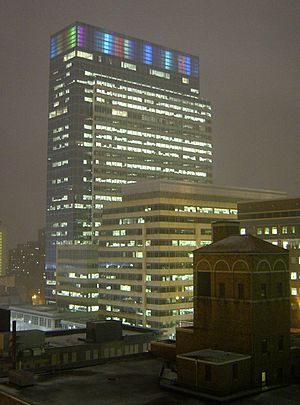
Target Corporation's main office is on Nicollet Mall in Minneapolis. This is near where the first Goodfellows store was. The office complex includes Target Plaza North and Target Plaza South. These buildings provide office space for 6,000 employees. In October 2014, Target also finished building a large corporate campus in Brooklyn Park, Minnesota. It is called Target Northern Campus.
Brian Cornell is the chairman and CEO of Target Corporation. In January 2016, he started visiting customers' homes. He wanted to better understand what customers need.
Target's Focus on Diversity
Target believes that "individuality may include a wide spectrum of attributes." This means they value people of different ages, races, genders, and backgrounds.
In 2008, Target settled a lawsuit with the National Federation of the Blind. The lawsuit claimed Target's website was hard for blind customers to use. Target agreed to improve its website for everyone. In 2009, the Equal Employment Opportunity Commission (EEOC) sued Target. They said Target did not help an employee with disabilities enough.
In February 2012, Target gave employee discounts to same-sex partners. The company had a perfect score on the Human Rights Campaign Corporate Equality Index.
The National Association for the Advancement of Colored People (NAACP) has given Target low grades. This was for how much the company supported African-American communities. Target said it sees diversity as including all people, not just one group.
In September 2020, Target shared a "Workforce Diversity Report." It showed that 50% of Target's employees are people of color. More than half are women. In leadership roles, 24% are people of color and 42% are women.
After events in Minneapolis in 2020, Brian Cornell said Target would do more for diversity. He promised to spend over $2 billion with Black-owned businesses by 2025. However, in 2025, Target announced changes to these policies. They said they would stop many programs for diversity, equity, and inclusion. They also said they would no longer join outside diversity surveys. Following this, Twin Cities Pride announced Target would not be part of the 2025 Pride Festival.
Target's Giving Back to Communities
Target is known for being one of the most generous companies in the U.S. It gives about 5% of its profits to communities. This is over $3 million each week. Target also gives money to schools. This comes from charges made with its Target Visa card. So far, Target has given over $150 million to schools this way.
Target also helped create the Target House in Memphis, Tennessee. This place offers long-term housing for families of patients at St. Jude Children's Research Hospital. Target donated over $27 million. This provided 96 furnished apartments for families staying at St. Jude for a long time.
Target usually does not allow groups to ask for money at its stores. This is to give shoppers a "distraction-free" experience. But they used to make exceptions for the Salvation Army during holidays. In 2004, Target asked the Salvation Army to find other ways to work together. Target still gives money to local Salvation Army groups through its grant program.
In 2005, Target and the Salvation Army created "The Target/Salvation Army Wish List." People could donate goods online for hurricane victims. In 2006, they started "The Target/Salvation Army Angel Giving Tree." This was an online version of the Angel Tree program.
Target also helps a lot during disasters. It gave money and products after the September 11 attacks. It also donated to help after the 2004 tsunami and Hurricane Katrina in 2005. Target also lets relief groups use its stores as command centers. It donates supplies like water. Target often gives its unused or returned items to Goodwill Industries.
Target's Environmental Efforts
In 2007, Target Corporation agreed to sell fewer products with polyvinyl chloride (PVC). Tests found harmful lead and other chemicals in many products. These chemicals can cause health problems. Target is also working to use less energy. They have energy-efficient stores and recycling programs. All Target stores in the U.S. use plastic shopping carts with metal frames. In 2006, they started using carts made completely of plastic.
Target released a report in 2007 about its plans to be more eco-friendly. They are installing sand filters for wastewater. Recycling programs target hangers, cardboard, electronics, and more. All Target stores in Oklahoma use wind power. Stores nationwide use only LED and fluorescent lights. They also have low-flow restrooms to save water. Some Target stores have green roofs. These roofs help with stormwater and keep buildings cooler. There are four green-roof Target stores in Chicago.
Target sells over 700 organic and eco-friendly products. These include organic cotton clothes and non-toxic cleaners. Since 2007, Target has offered reusable shopping bags. Target gift cards are made from corn-based materials. Target is also working to reduce plastic packaging.
Target is the only national retailer with a Garment Hanger reuse program. This program keeps millions of pounds of metal and plastic out of landfills. In 2007, it stopped 434 million hangers from going to landfills.
In 2009, California sued Target. They said Target stores were illegally dumping hazardous wastes. In October 2009, Target paid a $600,000 fine. This was for selling toys with too much lead paint. In February 2010, Target removed "message bears" from shelves. These bears also had too much lead.
In 2014, a lawsuit was filed against Target. It claimed Target misled customers by calling its "up & up" brand wet wipes "flushable." The lawsuit said these wipes clog pipes.
On April 27, 2017, Target announced a goal to put solar panels on 500 buildings by 2020. These panels would reduce a store's energy needs by 15% to 40%. Target also put its first solar bullseye logo on a distribution center in Phoenix, Arizona.
On December 5, 2018, Target was fined $7.4 million. This was for illegally putting e-waste, medical supplies, and private information into the trash.
On April 23, 2018, Target announced plans to add electric vehicle charging stations. They planned over 600 spaces at more than 100 sites in 20 states.
On March 17, 2022, Target announced its first net zero energy store. This store is in Vista, California.
Customer Information Safety
In December 2013, Target had a data breach. This affected up to 110 million customers. Their names, phone numbers, emails, and addresses were taken. In March 2015, Target settled a lawsuit with affected customers for $10 million. In May 2016, Target settled with banks and credit unions for $39 million.
Target Around the World
As of 2023, Target only has stores in the United States. In the past, Target tried to open stores in Canada. Other companies named "Target" outside the U.S. are not owned by Target Corporation.
There is a company in Australia with the same logo and name. But these stores are not connected. It is possible that the similar branding happened by chance. Both Target Australia and Target Corporation changed their names and designs from older, unrelated stores.
How Target Treats Its Employees
In 2015, Target raised its lowest pay to $9 per hour. In 2017, Target said it would raise this to $11 by October 2017. They also promised to reach $15 per hour by 2020. By April 2019, the pay was $13 per hour. In June 2020, Target announced that the minimum hourly wage would permanently rise to $15. This happened earlier than planned.
As a thank you to employees who worked during the COVID-19 pandemic in the United States, Target gave a $200 bonus in July 2020. During the pandemic, Target also offered more help to employees. This included virtual healthcare and paid time off for certain medical reasons. In February 2021, Target offered employees up to four hours of pay for getting both doses of the COVID-19 vaccine. They also covered Lyft rides to vaccine appointments. In August 2021, Target announced a $200 million plan. This plan offers debt-free college degrees to over 340,000 employees.
In December 2021, an employee in Indianapolis filed a complaint. He said a manager took union flyers he was giving out.
Target's Brand and How It's Different
Target's Logos
How Target Stands Out
Target has always tried to be different from other discount stores. It offers more stylish items at lower prices. Douglas J. Dayton, one of the founders, explained this idea. He said they would sell good quality items at low prices by cutting costs.
Because of this, Target stores often attract younger customers. The average Target shopper is 40 years old. This is younger than shoppers at other big discount stores. About 76% of Target customers are women. More than 43% have children at home. About 80% have gone to college.
In October 2008, Target wanted to show that its products were not more expensive. It added fresh foods and focused on advertising value. Target also slowed down opening new stores.
Target stores are designed to be more appealing. They have wider aisles and a nicer look for products. Some stores, especially near airports, have a bullseye painted on the roof. This can be seen from above. For example, the store in Inglewood, California, near Los Angeles International Airport, has an LED bullseye logo on its roof made of solar panels.
Target stores do not sell firearms. In the early 1990s, they stopped selling realistic toy guns. In 2014, Target asked guests not to bring firearms into stores. They also do not sell tobacco products. Most Target stores do not play music. However, this started to change in 2017 with a rebranding effort.
In July 2025, Target stopped its policy of matching competitor prices. This means they no longer match prices with stores like Amazon or Walmart. Now, Target only matches prices from its own stores or website within 14 days of purchase.
The "Targét" Nickname
Some people jokingly pronounce Target as "Targét," like a fancy French store. This nickname has been around since 1962. Target even sold a shoe line called "Miss Targé" once. This pronunciation has made some people think the company is French. In 2006, Target even used the name "Targét Couture" for a clothing line.
How Target Names Its People
Target uses special names for its customers and employees. This idea came from The Walt Disney Company in 1989. Customers are called "Guests." Regular employees are "Team Members." Supervisors are "Team Leaders." Managers are "Executive Team Leaders (ETLs)." The store manager is the "Store Team Leader (STL)." There are also "District Team Leaders" and other higher-level executives.
This naming system started to change in 2018. For example, the Store Team Leader became the Store Director. Front-of-store team members are now "Guest Advocates." People in Style, Beauty, and Tech are "Consultants." Other areas like General Merchandise have "Experts." Security officers are "Specialists." In distribution centers, employees are "Team members," "Operations manager," and "Leads."
Products and Partnerships
Target has special deals with many designers and brands. These include Finnish design company Marimekko, architect Michael Graves, and shoe company Converse. They also work with fashion designers like Lilly Pulitzer and Isaac Mizrahi. Target also created its "Go International" line. This line features collections by famous designers for a short time.
In 1999, Target launched its first designer product line. This was the Michael Graves Collection of home goods. Other stores like Walmart and Kmart have also started working with designers. Target also partners with well-known national brands for special collections.
In 2005, Target changed its prescription bottles. This was called the ClearRx system. The bottles were color-coded and had more space for labels. This system was invented by a student named Deborah Adler. It was called one of TIME's "Most Amazing Inventions of 2005." When Target sold its pharmacies to CVS Health in 2015, CVS stopped using ClearRx.
Sometimes, companies make red items just for Target. In 2002, Nintendo made a red Game Boy Advance with the Target logo.
In 2005, IFC worked with Target to promote independent films. These films were sold in Target stores and shown on IFC.
In 2016, Target started to market toys without saying if they were for "boys" or "girls." This change came after they stopped using pink and blue colors for toy aisles. This idea was also used for the Pillowfort children's decor line in 2016. It has more gender-neutral designs.
In February 2021, Target announced it would open "mini Apple shops" in some of its stores.
Gift Cards
The Target GiftCard is a gift card that holds money. Target sells more gift cards than any other retailer in the United States. They are also one of the top sellers in the world. Their unique card designs help them sell more. Target gift cards also have no expiration dates or fees.
Some designs have lenticular printing (images that change), "scratch and sniff" scents, or LED lights. There was even a gift card that was part of a bubble blower. A current eco-friendly gift card is made from corn-based plastic. In 2006, Target released an MP3 player gift card. It held 12 songs and cost at least $50.
Some of these unique designs are patented by Target Brands. For example, a wooden gift card design has a patent. A gift card with an edible product also has a patent.
Target GiftCards are also collected by some people. Some of the first cards are worth over $300, even without money on them. Every year, Target releases new Holiday GiftCards. In 2007, these included a wind-up flashlight and a musical gift card.
Since January 2010, Target has offered Mobile GiftCards. You can show a GiftCard barcode on your phone. This barcode can be scanned at Target stores. You can also check balances and send gifts using your phone.
Target's Forensic Services
In 2006, The Washington Post reported that Target had two criminal forensics laboratories. One was at its main office, and the other in Las Vegas. These labs were first used to investigate theft and fraud within Target. Later, they started helping police agencies across the country for free. Target's Forensic Services has helped federal agencies like the Federal Bureau of Investigation.
Target's Major Sponsorships
Events
- Target often supports big awards shows. These include the Emmys, Golden Globes, Grammys, and Oscars.
- Target Corporation is a big sponsor of the annual Minneapolis Aquatennial. It hosts the Target Fireworks Show. This is the largest annual fireworks show west of the Mississippi River.
- Target sponsored the 2006–2007 New Year's Times Square Ball drop. Its logo was on the confetti and special glasses.
Sports
Minnesota United FC
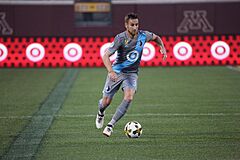
In January 2017, Minnesota United FC announced Target as its main jersey sponsor. This soccer team is part of Major League Soccer. Target also sponsors MLS overall. This was a big deal for a new team.
Major League Soccer and US Youth Soccer
In 2017, Target announced its biggest push into team sports. Target became an official partner of Major League Soccer. This deal includes ads during MLS games and chances for in-stadium experiences. Target also promised $14 million for youth soccer. This includes an $8 million grant program. It also includes a $6 million partnership with the U.S. Soccer Foundation. This will build 100 new soccer play spaces by 2020. Target is also the official sponsor of the 2017 and 2018 MLS All-Star Games.
Extreme Sports
Target sponsors many professional extreme sports athletes. These include freestyle motocross rider Nate Adams, snowboarder/skateboarder Shaun White, skateboarder Paul Rodriguez, BMX rider Mat Hoffman, and surfer Kolohe Andino.
Motocross
Target sponsors Motocross and Supercross champion Ryan Dungey.
Chip Ganassi Racing
Target was a long-time sponsor of the IndyCar and NASCAR racing teams of Chip Ganassi Racing. Target's relationship with Ganassi in IndyCar started in 1990. Famous drivers like Jimmy Vasser and Alex Zanardi won championships with Target's sponsorship. The team won its first Indianapolis 500 in 2000.
In NASCAR, Target sponsored cars driven by Jimmy Spencer and Casey Mears. Later, Kyle Larson drove the No. 42 car with Target sponsorship.
The Target Chip Ganassi car, driven by Dario Franchitti, won the 94th running of the Indianapolis 500 on May 30, 2010.
Target stopped sponsoring IndyCar racing at the end of 2016. In July 2017, Target announced it would also end its NASCAR sponsorship with Ganassi's team.
Naming Rights
Target owns the naming rights for the Minnesota Timberwolves' home, Target Center. This started when it opened in 1990. Target also bought the naming rights for the Minnesota Twins' baseball park, Target Field. This agreement lasts until 2035.
Radio
Target was the first sponsor of the Weekend America radio program.
Newspaper
Dainik Target is a new Bengali-language daily newspaper in Bangladesh. It started in Dhaka in 2024. It is owned by the Target Group. The newspaper covers news on many topics. It aims to be fair and factual.
Images for kids
See also
 In Spanish: Target Corporation para niños
In Spanish: Target Corporation para niños



